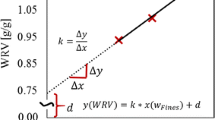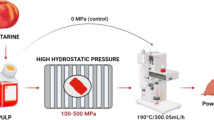Abstract
The state of water in wet pulps was studied over a wide moisture range, reflecting the conditions on the paper machine from the press section to the reel. Two methods were used: water retention value (WRV) and differential scanning calorimetry (DSC). To increase the measuring accuracy, a modification to the WRV procedure was introduced. The results were directly compared by plotting the values over the observed moisture range. Different types of water were defined from DSC data: free water, freezing bound and non-freezing bound water. The water types were plotted in water distribution charts against the solids content. These charts were compared with the WRV data. For all pulps, the three water fractions were found to be interdependent while the free water removal rate decreased. Water removal did not take place as an independent water fraction removal sequence. The presence of fines and pulp recycling were found to influence the amount of freezing bound water, but not non-freezing bound water. The results showed an irreversible decrease in WRV (hornification) for all investigated pulps in the range of 20–75% solids content. This pattern corresponded to the relative amount of free water present. Freezing bound water disappeared at a solids content of over 80–85%. With the absence of free water, no further hornification occurred. It was concluded that the WRV appears to be reduced by a closure of large voids by adhesion of the cellulosic pore walls. The softening effect of water is required to cause ‘wet hornification’ of the structure.
Similar content being viewed by others
References
Abson, D. and Gilbert, R. D. (1980) Observations on water retention values.Tappi J.,63(9), 146–147.
Anon. (1957)ZELLCHEMING Merkblatt IV/33/57.
Anon. (1981) Water Retention Value (WRV), Useful Test Method UM256. TAPPI.
Carlsson, G. and Lindström, T. (1984) Hornification of cellulose fibres during wet pressing.Svensk Papperstidning,87(15), R119-R125.
De Ruvo, A. and Htun, M. (1981) Fundamental and practical aspects of paper-making with recycled fibres. InThe Role of Fundamental Research in Paper Making, (J. Brander, ed.) Vol. 1, London: BPBIF, Mechanical Engineering Publications Ltd., p. 195.
Deodhar, S. and Luner, P. (1980) Measurement of bound (nonfreezing) water by differential scanning calorimetry. InWater in Polymers, (S. P. Rowland, ed.) Washington: American Chemical Society, p. 273–286.
Höpner, T., Jayme, G. and Ulrich, J. C. (1955) Bestimmung des Wasserrückhaltevermö gens (Quellwertes) von Zellstoffen.Das Papier,9(19/20), 476–482.
Jayme, G. (1944) Mikro-Quellungsmessungen an Zellstoffen.Der Papier-Fabrikant/Wochenblatt für Papierfabrikation, (6), 187–194.
Jayme, G. and Büttel, H. (1966) Über die Bestimmung und Bedeutung des Wasserrü ckhaltevermögens (des WRV-Wertes) verschiedener gebleichter und ungebleichter Zellstoffe.Das Papier,20(7), 357–366.
Krause, T. and Le Thi, P. C. (1985) Faserstruktur, Wasserbindung, Trocknung.Das Papier,39(10A), V24-V32.
Laivins, G. Y. and Scallan, A. M. (1993) The mechanism of hornification of wood pulps. InProducts of Papermaking. Tenth Fundamental Research Symposium, (C. F. Baker, ed.) Oxford, September 1993: Pira International, p. 1235–1260.
Maloney, T. C., Li, T.-Q., Weise, U. and Paulapuro, H. (1996) Intra- and inter-fiber pore closure in wet pressing. In50th Appita General Conference, Vol. 2, Auckland: 6–10 May 1996, Appita, p. 647–654.
Nakamura, K., Hatakeyma, T. and Hatakeyma, H. (1981) Studies on bound water of cellulose by differential scanning calorimetry.J. Textile Inst. 72(9), 607–613.
Nakamura, K., Hatakeyama, T. and Hatakeyama, H. (1987) DSC studies on monovalent and divalent cation salts of carboxymethylcellulose in highly concentrated aqueous solutions. InWood and Cellulosics (J. F. Kennedy, G. O. Phillips, and P. A. Williams, eds) Ellis Horwood Ltd., p. 97– 103.
Nelson, R. A. (1977) The determination of moisture transitions in cellulosic materials using differential scanning calorimetry.J. Appl. Polym. Sci.,21, 645–654.
Robertson, A. A. (1963) The physical properties of wet webs.Svensk Papperstidning,66(12), 477–497.
Robertson, A. A. (1964) Some observations on the effects of drying papermaking fibres.Pulp Paper Mag. Canada. 65(3), T161-T168.
Salmén, L. (1993) Responses of paper properties to changes in moisture content and temperature. InProducts of Papermaking. Tenth Fundamental Research Symposium, (C. F. Baker, ed.) Vol. 1, Oxford, September 1993: Pira International, p. 369–430.
Scallan, A. M. (1977) The accomodation of water within pulp fibres. InFibre-Water Interactions in Papennaking, Vol. 1, Oxford, September 1977: Trans. BPBIF Symposium, p. 9–27.
Smook, G. A. (1990) Hornification (keyword). InHandbook of Pulp & Paper Terminology, Vancouver: Angus Wilde Publications, p. 135.
Stone, J. E. and Scallan, A. M. (1966) Influence of drying on the pore structures of the cell wall. InConsolidation of the Paper Web, (F. Bolam, ed.), London: B. P. & B. M. A., p. 145–174.
Weise, U. and Paulapuro, H. (1995) Changes of pulp fibre dimensions during drying. InInternational Paper Physics Conference, Niagara-on-the-Lake, 11–14 September 1995: CPPA and TAPPI, p. 121–124.
Weise, U. and Paulapuro, H. (1996) Der Zusammenhang zwischen Faserschrumpfung und Verhornung.Das Papier 50(6), 328–333.
Welin Fogelberg, I. (1995) Determination of Water Retention Value (WRV), SCAN-test SCAN-C 102XE.SCAN, March 10, 1995. First proposal.
Yamauchi, T. and Hasegawa, A. (1993) Determination of PEG concentration in its aqueous solution using differential scanning calorimetry.J. Appl. Polym. Sci.,49, 1653–1658.
Yamauchi, T. and Murakami, K. (1991) Differential scanning calorimetry as an aid for investigating the wet state of pulp.J. Pulp Paper Sci.,17(6), J223-J226.
Author information
Authors and Affiliations
Corresponding author
Rights and permissions
About this article
Cite this article
Weise, U., Maloney, T. & Paulapuro, H. Quantification of water in different states of interaction with wood pulp fibres. Cellulose 3, 189–202 (1996). https://doi.org/10.1007/BF02228801
Issue Date:
DOI: https://doi.org/10.1007/BF02228801




